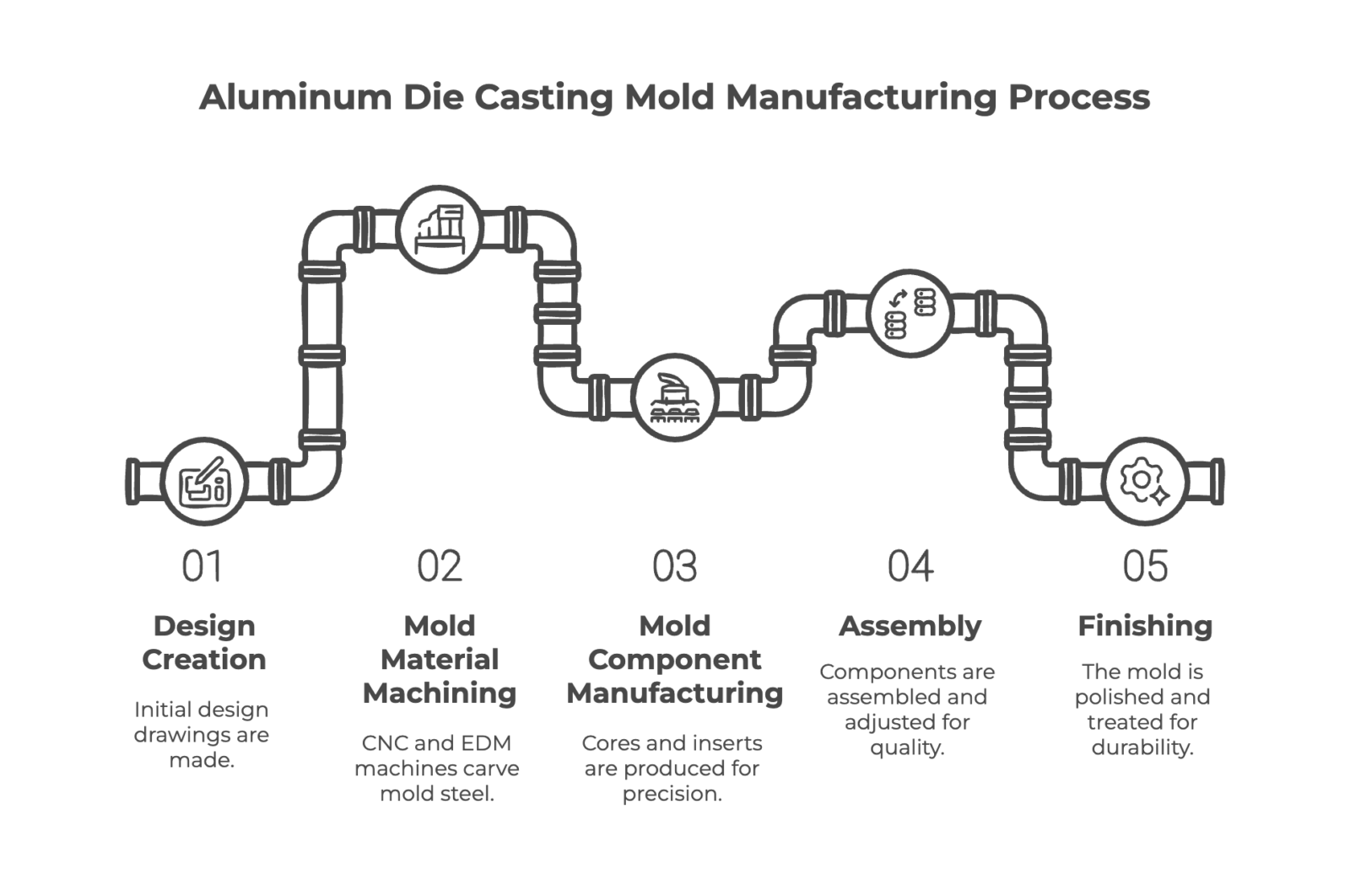◆Table of contents
ToggleIntroduction
In modern society, aluminum die casting molds are indispensable tools for manufacturing various products such as automobiles, home appliances, and industrial equipment. They are widely adopted in various industrial fields because they can efficiently mass-produce products with high dimensional accuracy and surface quality.
Aluminum die casting molds are a technology that injects molten aluminum alloy into a mold and forms parts with complex shapes in a short time. However, their design, manufacturing, and maintenance require specialized knowledge and experience.
This paper comprehensively explains the basic knowledge of aluminum die casting mold design, manufacturing, and maintenance to support optimal mold selection and utilization. By explaining the structure, materials, design/manufacturing process, maintenance methods, etc. of molds, we aim to be a valuable source of information for those interested in aluminum die casting molds.
Aluminum Die Casting Mold Design
Aluminum die casting mold design is an important process for efficiently producing high-quality products.
| Item | Content | Remarks |
|---|---|---|
| Mold Structure | Composed of fixed mold, movable mold, cores, etc. | Design considering product shape, size, and productivity |
| Material Selection | Mold material: Mold steel (SKD61, etc.) Die casting material: Aluminum alloy (ADC12, etc.) | Affects product quality and mold life |
| CAE Analysis | Flow analysis, strength analysis | Improve mold design accuracy, avoid troubles |
| Cooling Design | Cooling circuit, cooling medium (water, oil, etc.) | Improve product quality, shorten production cycle, extend mold life |
| Gate Design | Gate position, gate shape | Affects product quality, suppresses melt flow defects and gas entrainment |
Mold Structure
Aluminum die casting molds are composed of fixed molds, movable molds, cores, etc., and are designed considering product shape, size, and productivity. Complex shapes require multiple movable molds and cores.
Material Selection
Mold materials use mold steel (SKD61, etc.) with excellent high-temperature strength, wear resistance, and toughness, and die casting materials use aluminum alloy (ADC12, etc.) with excellent castability, mechanical properties, and corrosion resistance. Material selection greatly affects product quality and mold life.
CAE Analysis
CAE analysis helps improve mold design accuracy and avoid troubles. Flow analysis predicts melt flow defects and gas entrainment, and strength analysis predicts mold strength insufficiency and deformation, identifying problems at the design stage and taking countermeasures.
Cooling Design
Die casting molds handle high-temperature molten aluminum alloy, so proper cooling design is essential. The cooling circuit is designed to cool the entire mold uniformly, and water or oil is used as the cooling medium. Proper cooling design enables product quality improvement, production cycle shortening, and mold life extension.
Gate Design
The gate is the path through which molten aluminum alloy flows into the mold, and its position and shape greatly affect product quality. Optimal gate design suppresses problems such as melt flow defects and gas entrainment, enabling the manufacture of high-quality products. Gate design needs to consider product shape, size, die casting machine capacity, etc.
Aluminum Die Casting Mold Manufacturing
Aluminum die casting mold manufacturing is the process of creating a precise mold based on design drawings.
Mold Material Machining
This includes cutting processes that use CNC machines to carve high-precision shapes from blocks of mold steel, and electrical discharge machining (EDM) for processing hard materials and complex shapes. High machining accuracy is required.
Mold Component Manufacturing
Cores and inserts are components that form complex shapes inside the product and are manufactured by cutting or electrical discharge machining. High precision and durability are required.
Assembly
This is the process of combining mold materials, cores, inserts, etc. to complete the mold. Mold matching and adjustment are carefully performed because they greatly affect product quality.
Finishing
This involves polishing to smooth the mold surface and surface treatments (nitriding, PVD coating, etc.) to improve wear resistance and corrosion resistance. It is necessary to select appropriate methods and perform them carefully because they greatly affect mold performance and life.
Aluminum die casting molds are completed through these manufacturing processes. High technical skills and quality control systems are required in each process.
Aluminum Die Casting Mold Maintenance
Proper maintenance is crucial for aluminum die casting molds as they wear and deteriorate with repeated use.
Daily Inspection
- Simple inspection performed before daily use, including:
- Cleaning
- Lubrication
- Simple checks (visual inspection, checking movable parts)
- Neglecting this leads to accelerated wear and damage, negatively impacting product quality.
Periodic Inspection
- Detailed inspection performed at regular intervals, including:
- Part replacement
- Repairs
- Precision measurements (dimensional and shape accuracy)
- Proper execution extends mold life and reduces unexpected failures.
Life Management
- Understanding the condition of molds that wear and deteriorate with usage and time.
- Aiming to maximize mold life through timely repairs and replacements, including:
- Early detection of signs of wear and damage
- Regular inspections and records
- Professional diagnosis
- Proper execution maximizes mold life and reduces costs.
Proper maintenance is essential for stable production of high-quality products. Perform daily inspections, periodic inspections, and life management appropriately to ensure long and valuable use of molds.
Precautions and Challenges in Design, Manufacturing, and Maintenance
Aluminum die casting mold design, manufacturing, and maintenance require advanced technology and experience. The precautions and challenges for each process are as follows.
Design Phase
Design errors lead to rework in manufacturing and shortening of mold life. Especially, cooling and gate design greatly affect product quality. CAE analysis is useful but should not be overrelied upon. Material selection also affects product quality and mold life.
Manufacturing Phase
High machining accuracy is required for mold material machining and mold component manufacturing. Cost management and delivery management are also important.
Maintenance Phase
Neglecting daily inspections accelerates mold wear and damage. Periodic inspections are important to extend mold life and reduce failures. Life management is also important to understand mold conditions and perform repairs and replacements at the right time.
Common Challenges
Human resource development and response to technological innovation are also important.
By understanding these precautions and challenges and taking countermeasures, aluminum die casting mold design, manufacturing, and maintenance can be successful.
Considerations for Cost, Delivery Time, and Quality
In aluminum die casting mold design, manufacturing, and maintenance, balancing cost, delivery time, and quality is crucial.
Cost
Cost reduction is possible through efforts from the design stage (reducing the number of parts, adopting standard parts), selecting efficient machining methods, effectively utilizing materials, and selecting outsourcing partners (considering not only price but also technical capabilities and delivery compliance rate).
Delivery Time
Delivery time reduction is possible by streamlining the design and manufacturing processes, utilizing CAD/CAM/CAE, strengthening cooperation with partner companies, and thoroughly managing progress.
Quality
High-quality products can be manufactured by ensuring quality at the design stage, managing quality at the manufacturing stage, establishing an inspection system, and thoroughly performing maintenance.
Cost, delivery time, and quality are interrelated, and optimal mold design, manufacturing, and maintenance that considers the balance is important.
Daiwa Keikinzoku’s Strengths
Daiwa Keikinzoku leverages its long-cultivated outstanding technology and extensive experience to demonstrate the following strengths in aluminum die casting mold design, manufacturing, and maintenance.
- Advanced Design Technology: Realizes mold designs that can efficiently produce high-quality products through flow and strength analysis using CAE analysis, and proposes optimal mold structures and cooling/gate designs that consider customer requests and product characteristics.
- Precision Manufacturing Technology: Manufactures high-precision molds according to design drawings by utilizing advanced machining technologies such as CNC machining and electrical discharge machining by the latest equipment and skilled engineers. Also builds a strict quality control system and stably supplies high-quality molds.
- Comprehensive Maintenance System: Builds a comprehensive maintenance system to maximize mold life and provides various maintenance services such as daily and periodic inspections, and life management. Professional engineers respond quickly and carefully to minimize customer downtime.
- Extensive Track Record and Customer Trust: The extensive track record of providing aluminum die casting molds to customers in various fields such as automobiles, home appliances, and industrial equipment, and the high trust from customers prove the high level of Daiwa Keikinzoku’s technology. Customers have expressed opinions such as, “We can trade with confidence because the quality is high and delivery times are met.”
Summary
Aluminum die casting molds are indispensable tools for manufacturing various products in modern society, and their importance is increasing. This paper comprehensively explained the basic knowledge of aluminum die casting mold design, manufacturing, and maintenance to support optimal mold selection and utilization.
In aluminum die casting mold design, various factors such as mold structure, material selection, CAE analysis, cooling design, and gate design need to be considered. In manufacturing, precise machining technologies such as mold material machining, mold component manufacturing, assembly, and finishing are required. Furthermore, in maintenance, it is important to build a proper management system such as daily inspections, periodic inspections, and life management.
Daiwa Keikinzoku has cultivated outstanding technological capabilities and extensive experience in aluminum die casting mold design, manufacturing, and maintenance for many years. Advanced design technology, precision manufacturing technology, comprehensive maintenance system, extensive track record, and customer trust underpin Daiwa Keikinzoku’s strengths.
Please feel free to contact Daiwa Keikinzoku if you have any questions or requests regarding aluminum die casting molds.

